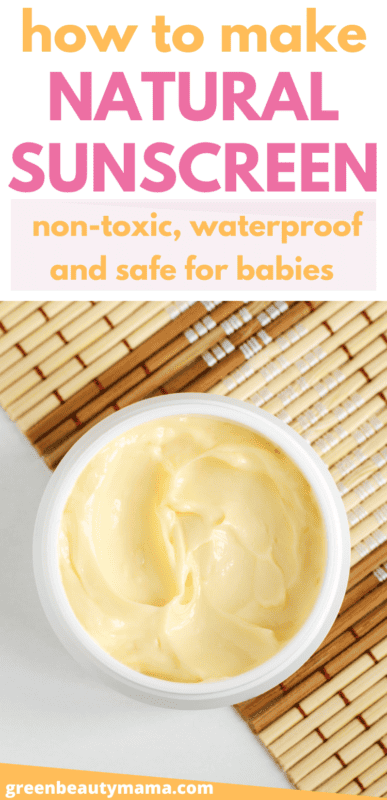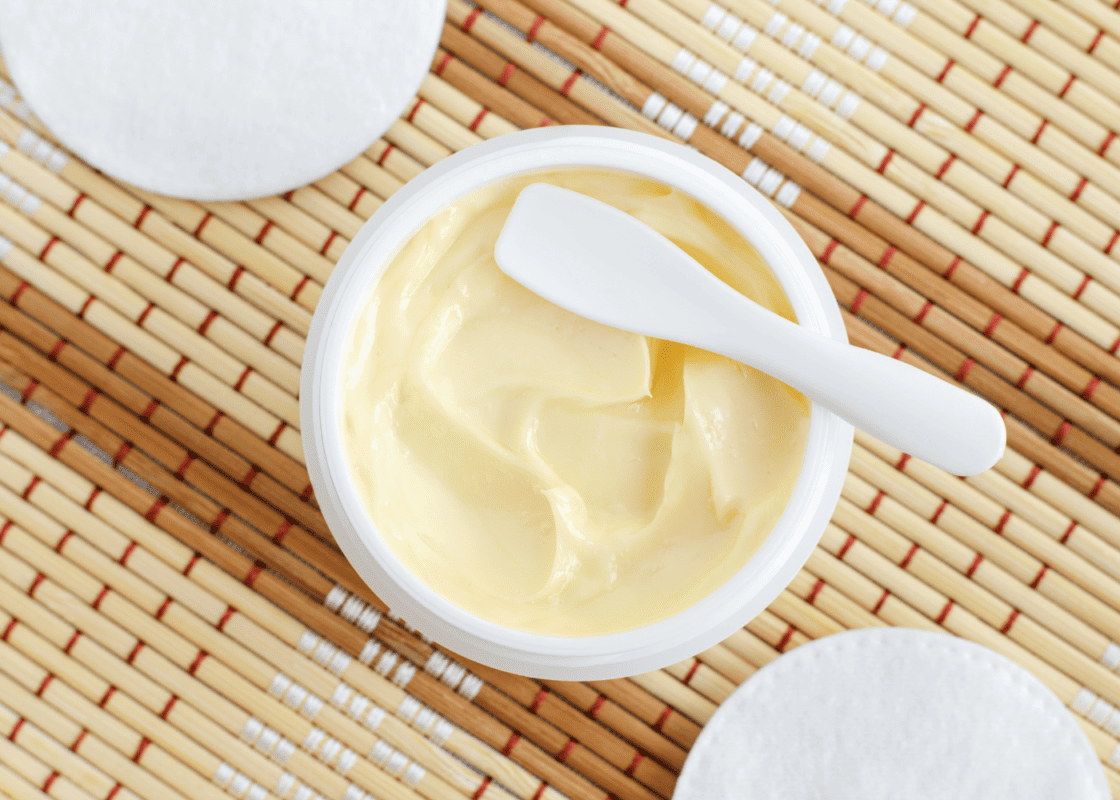This homemade waterproof sunscreen is a simple and organic make-ahead summer skincare recipe. The DIY sunscreen is made with all-natural ingredients and will protect you against UVA and UVB rays.
If you like my beauty recipes, join my Facebook group 🎉 This is the best place for broader DIY beauty stuff, behind-the-scenes, what I’m working on in real-time, and more!
💡 Do you dream of a perfect skincare routine (and products) but feel it’s impossible since your budget is limited? Grab the recipes I’m using to craft 100% natural DIY beauty products that give top beauty brands a run for their money! ❤️ HOMEMADE BEAUTY MADE SIMPLE ❤️

Then, when I tried my first batch of homemade sunscreen, I was immediately won over! This summer skincare recipe is not only effective but also safe for kids. This organic sunscreen is also waterproof, making it an excellent option for the pool or for working outside and sweating.
One batch of this homemade waterproof sunscreen recipe should last an entire summer; if not, make another one and enjoy.

This organic sunscreen recipe doesn’t contain harmful ingredients like endocrine disruptors or compounds harmful to coral reefs. In fact, this waterproof sunscreen is made with effective active ingredients like aloe vera gel that could heal and protect the skin from burns.
Plus, as a homemade version, I’ve added zinc oxide to protect the skin AGAINST UVA and UVB rays. In fact, zinc oxide is a non-toxic and effective broad-spectrum sunblock. So, I’ll take that as a win!
A report from the EWG found numerous sunscreen ingredients at unsafe concentration levels. Studies also found that some ingredients are absorbed and remain in the body for weeks, even after just one use.
The Ingredients
Coconut oil – contains natural SPF properties. It blocks only 20 per cent of the sun’s damaging rays.
Aloe vera is a good active ingredient in homemade sunscreen. It’s been proven to both treat and prevent burns on the skin.
Shea Butter – naturally protects skin, making it perfect for use in homemade organic sunscreen.
Raspberry Seed oil – contains powerful anti-oxidants and vitamin E to help fight free radicals, renew skin cells, and improve tone/elasticity. It has an SPF against UVB rays of 28-50 and an SPF against UVA rays of around 8.
Zinc oxide (non-nano) – a non-toxic, effective broad-spectrum sunblock. The particles sit on the outermost layer of your skin, scattering and absorbing UVA and UVB rays, protecting the skin below.
Walnut extract oil contains rich vitamins and minerals, making it beneficial for achieving smooth and youthful skin. It also protects against UV rays and is attractive to the sun. Additionally, due to its properties, it is effective in treating sunburn. Furthermore, due to its high content of essential fatty acids, walnut oil is excellent for moisturizing the skin before and during sun exposure.

Homemade Waterproof Sunscreen recipe
From my experience and research, homemade sunscreens may not be as waterproof as mineral-based sunscreens. Also, they have as high or broad spectrum SPF. That said, always remember that homemade versions may not protect as fully against the sun’s rays. Don’t get me wrong; I do not recommend avoiding sunscreen or getting too much sun, which could lead to sunburn or damage.
Ingredients:
- 1/4 cup Shea butter for a spreadable consistency
- 1/4 cup Coconut oil (natural SPF of 7)
- 2 tbsp Zinc Oxide powder (natural SPF of 20)
- 1 teaspoon Red Raspberry Seed Oil (SPF 25-50)
- 1/4 cup pure Aloe Vera gel (m (must be 50 per cent or higher pure aloe)
- 25 drops of walnut extract oil for scent and an added SPF boost
How to make organic sunscreen
- Combine everything except the zinc powder and aloe vera gel in a double boiler.
- Heat water to a simmer and melt all ingredients, stirring well to combine.
- Let it cool for several minutes before stirring in the aloe vera gel.
- Cool completely before adding zinc oxide. Mix well to make sure the zinc oxide is distributed throughout.
- Put a tight lid on the jar and shake well. Avoid breathing in the zinc powder. Wrap a towel around the jar to help when you shake it!
- Once sunscreen has started to thicken but is still pourable, pour it into a glass container or a mason jar.
- Follow up with an after-sun lotion or spray.

How to store the DIY Sunscreen
Keep your sunscreen in a glass jar or a tightly sealed container. Remember that glass and water do not go well together if you plan to use this sunscreen at the pool during the warmer months. Use a plastic container instead, and avoid adding any essential oils. The sunscreen has a shelf life of one year, but its longevity will greatly diminish if it comes into contact with water.

Where do you get the ingredients?
Hi Tara, usually I get all my ingredients from Amazon.
Just curious what this mixtures SPF is as you have it written?
My grandson is allergic to all tree nuts. Can I use a different oil than the coconut oil?
What is the best container to store this in? Is it light sensitive?
For a storage container, you can either use a glass jar or a silicone squeeze tube.
So sorry to hear that. You can try sunflower oil or pumpkin seed oil. Hope it will work.
My homemade sunscreen recipe relies on two ingredients to provide SPF: zinc oxide and raspberry seed oil.
For SPF 2-5: Use 5% zinc oxide
SPF 6-11: Use 10% zinc oxide
For SPF 12-19: Use 15% zinc oxide
SPF 20+: Use 20% zinc oxide
Raspberry seed oil has a SPF profile of 30-50.
Is there something I can use to replace shea butter? And how many grams would it be a cup?
1 cup of shea butter equals more or less 214 g.
I don’t recommend replacing shea butter since it has many skincare benefits. While shea butter shouldn’t replace your sunscreen, it can offer some protection against harmful UV rays. Its natural protective qualities make shea butter a fantastic addition to sun protection products
New to this…. Can organic unrefined coconut oil be melted down or use a coconut carrier oil?
Yes it can, go ahead and use it
If you want SPF 20+ how many TBSP would you use?
We have bees and I am concerned about the scent of the Raspberry Oil attractiveness to them. Do you recommend doing without or another alternative? Thank you!
Hi, Rosehip oil would be a good alternative.
If I wanted to use bees wax would I add it before or after zinc? How much bees wax would you suggest?
Can I use aloe directly from my plant or should I buy a commercial aloe Vera gel?
It’s better to buy a commercial gel. Directly from the plant has many risks for your skin health.
This recipe doesn’t require beeswax. If you want to make a beeswax sunscreen you need to follow different formulation, like this one:
1 oz/ 30 g beeswax
2 oz / 60 g coconut oil
1 tsp zinc oxide
20 drops of your preferred essential oil
For an SPF of 12 to 19, measure out 1 ¼ to 1 ½ tbsp of Zinc Oxide. For an SPF over 20, measure out 2 tbsp of zinc oxide
Unfortunately Red Raspberry seed oil is not heat stable and is prone to oxidation. Everyone mentions how UV protective it is, but a search in published studies reveals that its PUFA content makes it unstable. Oils with high amounts of PUFAs are unstable and cause faster skin aging, unfortunately. It would be helpful if this were to be addressed by beauty websites and blogs in the future as many people are putting Red Raspberry thinking it will protect their skin against the sun when the opposite is likely to happen….especially in a sunscreen, where a heat-stable oil is crucial.
Thank you Tamy for sharing with us this really helpful information.
Wondering if you’ve noticed if this stains clothes at all?
So should we replace raspberry seed oil with rose hip oil in the sunscreen or is there another alternative? I am getting ready to order ingredients. Thanks
You can replace it if you want.
Raspberry oil – contains high levels of omega 3 and 6 fatty acids. It has a natural SPF between 28 and 50.
You can also use Carrot seed oil – a vegetable oil that has the maximum amount of SPF, between 38 and 40.
Some other oils:
Macadamia Oil – SPF 6
Non-GMO Soybean Oil – SPF 10
Avocado Oil – 4 – 10
Olive Oil – 2-8
Shea Butter – 3 – 6
Almond Oil – SPF 5
Sesame Seed Oil – SPF 4
Hemp Seed Oil – SPF 6
Jojoba Oil – SPF 4
Coconut Oil – SPF 2 – 8
How long does this formula last in the sun? How often should it be reappli d?
For best results I apply the sunscreen after a swim
Can the raspberry oil be substituted with something else?
How long it will last ? What will be expiry date and where to store
This sunscreen will last for one year. If water gets into this sunscreen, it will drastically reduce its shelf life.
Store sunscreen in a glass, airtight container. If you’ll be using this sunscreen at the pool this summer, remember glass and water don’t mix. In this case, keep it in a plastic container and do not use any essential oils in the recipe.
You can use rosehip oil or carrot seed oil, but note that they habe lower SPF
Not at all
I need to make this!
Cool, let me know how it goes 🙂